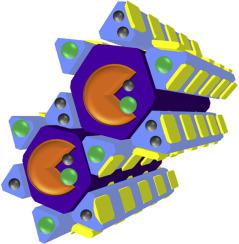Chem ( IF 19.1 ) Pub Date : 2018-03-29 , DOI: 10.1016/j.chempr.2018.03.001 Peng Li , Qishui Chen , Timothy C. Wang , Nicolaas A. Vermeulen , B. Layla Mehdi , Alice Dohnalkova , Nigel D. Browning , Dengke Shen , Ryther Anderson , Diego A. Gómez-Gualdrón , Furkan M. Cetin , Jacek Jagiello , Abdullah M. Asiri , J. Fraser Stoddart , Omar K. Farha

|
Highly efficient cell-free enzymatic systems are typically difficult to achieve in traditional immobilized enzyme systems because of the lack of optimal spatial control of enzyme localization, substrate and product diffusion, and enzyme and coenzyme accessibility. Here, we report a strategy for expanding the pore apertures (from 3.3 to 6.7 nm) of a series of Zr-based metallic-organic frameworks (MOFs) (termed NU-100x, x = 3, 4, 5, 6, 7) with interconnected hierarchical pores by maintaining precise control of torsional angles associated with the linkers. As a proof of concept, we use the expanded NU-100x MOF structures to encapsulate lactate dehydrogenase (LDH) and demonstrate the use of the captured protein in a cell-free biosynthetic catalytic system. Remarkably, LDH immobilized in the large pores of the MOF is accessible to nicotinamide adenine dinucleotide coenzymes (NAD and NADH), allowing for in situ coenzyme regeneration leading to higher activity than that of the free enzyme.
中文翻译:

面向无细胞固定化酶系统的分层工程介孔金属有机框架
由于缺乏对酶定位,底物和产物扩散以及酶和辅酶可及性的最佳空间控制,在传统的固定化酶系统中通常很难实现高效的无细胞酶系统。在这里,我们报告了一种策略,用于扩展一系列基于Zr的金属有机骨架(MOF)(称为NU-100x,x = 3、4、5、6、7)的孔径(从3.3到6.7 nm )通过保持对与连接子相关的扭转角的精确控制,使层状结构具有相互连接的分层孔。作为概念验证,我们使用扩展的NU-100xMOF结构封装了乳酸脱氢酶(LDH),并证明了捕获的蛋白质在无细胞生物合成催化系统中的用途。值得注意的是,固定在MOF大孔中的LDH可以通过烟酰胺腺嘌呤二核苷酸辅酶(NAD和NADH)获得,从而可实现原位辅酶再生,从而产生比游离酶更高的活性。











































 京公网安备 11010802027423号
京公网安备 11010802027423号